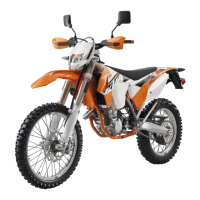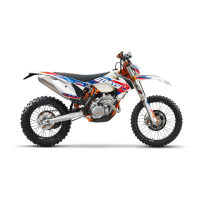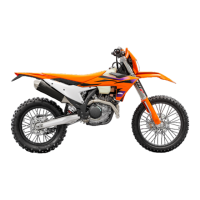Why are the lights not working on my KTM 500 XC-W USA?
- DdjonesSep 7, 2025
If the high beam, low beam, parking light, tail light, and license plate lamp are not working on your KTM Motorcycle, check if fuse 3 is blown and replace it.

Why are the lights not working on my KTM 500 XC-W USA?
If the high beam, low beam, parking light, tail light, and license plate lamp are not working on your KTM Motorcycle, check if fuse 3 is blown and replace it.
Why is the speedometer not working on my KTM 500 XC-W USA Motorcycle?
If the speedometer, horn, brake light, turn signal, and radiator fan are not working on your KTM Motorcycle, check if fuse 4 is blown and replace it.
Why is my KTM 500 XC-W USA Motorcycle battery discharged?
If the battery of your KTM Motorcycle is discharged, the alternator may not be charging it. Check the charging voltage and the stator winding of the alternator. Also, check for any undesired power consumers.
Why KTM 500 XC-W USA engine won't crank with electric starter?
If the electric starter on your KTM Motorcycle isn't cranking the engine, there could be a few reasons. You might be making an operating error, so double-check the start procedure. A discharged battery is a common cause, so try charging it. Also, a blown main fuse can prevent the starter from working, so replace it if needed. Finally, the starter relay or the starter motor itself could be defective, requiring a check of these components.
What does it mean when the FI warning lamp (MIL) lights up on my KTM 500 XC-W USA Motorcycle?
If the FI warning lamp (MIL) lights up or flashes on your KTM Motorcycle, it indicates a defect in the fuel injection system. Stop the motorcycle and identify the faulty part using the blink code. Check the cabling for damage and the electrical plug-in connections for corrosion and damage. You may also need to read out the fault memory using the KTM diagnostics tool.
| Engine Type | Single-cylinder, 4-stroke |
|---|---|
| Bore x Stroke | 95 mm x 72 mm |
| Throttle Body | 42 mm |
| Transmission | 6-speed |
| Fuel Tank Capacity | 9.5 liters |
| Cooling System | Liquid cooled |
| Rear Suspension | WP XPlor PDS |
| Front Brake | 260 mm disc |
| Rear Brake | 220 mm disc |
| ABS | No |
| Starter | Electric Starter |
| Displacement | 510.4 cc |
| Seat Height | 960 mm |
| Front Suspension | WP XPlor 48 |
| Ground Clearance | 370 mm |
| Fuel System | Keihin EFI, throttle body 44 mm |
Explains the meaning of various symbols used throughout the manual for clarity and safety.
Details the different typographical formats used in the manual, such as specific names and brands.
Defines the intended use of the motorcycle and provides essential safety instructions for operation.
Explains the different degrees of risk (Danger, Warning, Caution, Note) and their corresponding symbols.
Covers safe operation practices, the importance of protective clothing, and general work rules.
Details environmental considerations and emphasizes reading the Owner's Manual for proper usage.
Outlines conditions for warranty claims and the importance of authorized service for maintaining coverage.
Provides guidance on using approved substances and highlights the impact of service and difficult conditions.
Information on using genuine spare parts and accessing customer service for vehicle inquiries.
Illustrates and labels the front left view of the motorcycle, identifying key components and controls.
Illustrates and labels the rear right view of the motorcycle, identifying various controls and part numbers.
Details the location of the chassis number, type label, and key number for vehicle identification.
Specifies the location of the engine number and part numbers for the fork and shock absorber.
Covers clutch, brake, throttle, kill switch, horn, and light/turn signal switches for rider interaction.
Details electric starter, emergency OFF switch, and indicator lamps for safe engine operation.
Explains fuel cap operation, idle speed, shift/kick levers, foot brake, side stand, and steering lock.
Covers speedometer overview, activation, unit settings, clock, and function adjustments.
Explains various display modes like speed, service hours, lap times, odometer, and trip masters.
Covers speedometer overview, activation, unit settings, clock, and function adjustments for this model.
Explains various display modes like speed, service hours, lap times, odometer, and trip masters for this model.
Provides crucial safety advice for initial use, including protective gear and rider condition.
Guidelines for the engine running-in phase, specifying maximum engine speed and performance limits.
Advises on preparing the vehicle for specific conditions like sand, mud, high/low temperatures, and snow.
Details essential checks and maintenance steps to be performed before riding the motorcycle.
Guides on starting the engine, starting off, shifting gears, and proper riding techniques.
Explains braking techniques, safe stopping, parking, and vehicle transport procedures.
Provides instructions on safe refueling, including fuel type, tank capacity, and safety precautions.
Outlines the recommended service schedule based on operating hours and time intervals for routine maintenance.
Lists service tasks that can be performed as additional orders, categorized by operating hours and frequency.
Explains how to check and adjust the basic suspension settings according to the rider's weight.
Details adjusting low-speed and high-speed compression damping, and rebound damping of the shock absorber.
Covers checking and adjusting fork compression damping, rebound damping, and spring preload.
Guides on adjusting the handlebar position for rider comfort and control.
Instructions on how to safely raise the motorcycle using a lift stand and secure it.
Covers bleeding fork legs, cleaning dust boots, removing/installing fork protectors, and triple clamp service.
Procedures for removing and installing the shock absorber and front fender.
Details on removing/installing air filter, cleaning air filter box, and servicing the main silencer.
Covers removing/installing fuel tank, checking chain tension, cleaning, and checking chain components.
Guides on checking and adjusting the free travel and basic position of the hand brake lever.
Covers checking brake disc wear, thickness, and the fluid level in the front brake system.
Details checking and changing front and rear brake linings, including fluid checks and adjustments.
Guides on checking free travel and adjusting the basic position of the foot brake lever.
Step-by-step instructions for removing and installing the front wheel, including bearing checks.
Detailed procedures for removing and installing the rear wheel, including chain and adjuster steps.
Guidance on checking tire condition, tread depth, age, and air pressure for optimal performance.
Explains how to check and adjust spoke tension for wheel balance and durability.
Covers removing, installing, and charging the motorcycle battery for reliable power.
Guides on changing the main fuse and fuses for individual power consumers to resolve electrical issues.
Instructions for removing/refitting headlight mask, changing headlight and turn signal bulbs.
Details checking and adjusting headlight range and changing the speedometer battery.
Explains how to check antifreeze protection and coolant levels in the radiator for engine health.
Procedures for draining the old coolant and refilling the cooling system with new coolant.
Guides on checking and adjusting the play in the throttle cable for smooth throttle operation.
Details on adjusting idle speed and the basic position of the shift lever for optimal performance.
Instructions for changing the fuel screen to ensure proper fuel delivery to the engine.
Comprehensive guide to changing engine oil, oil filter, and cleaning oil screens for engine longevity.
Procedures for checking and adding engine oil, ensuring correct levels for engine health.
Provides guidelines for cleaning the motorcycle, including using cleaners and avoiding pressure damage.
Advice on checks and maintenance for winter operation, including protection against road salt corrosion.
Steps for preparing the motorcycle for long-term storage, including fuel, cleaning, and battery care.
Guidance on tasks required to prepare the motorcycle for use after a period of storage.
Diagnoses and solutions for issues like engine not cranking, not starting, or having low power.
Addresses engine overheating causes and troubleshooting the FI (MIL) warning lamp.
Lists blink codes for the FI warning lamp, indicating specific faults in the fuel injection system.
Provides engine design details, capacities, and precise tightening torques for engine components.
Details chassis dimensions, suspension types, electrical system components, and tire specifications.
Specific settings for fork and shock absorber, including damping, spring preload, and oil capacities.
Lists all chassis-related screws and nuts with their specified tightening torques and threadlocker recommendations.
Specifies approved brake fluid, coolant mixtures, and required fuel grade.
Details recommended engine oil (SAE 10W/50, 10W/60) and fork oil (SAE 4) specifications.
Lists recommended products for air filter cleaning, chain cleaner, metal protection, and fuel additives.
Recommends high viscosity grease, long-life grease, motorcycle cleaner, and universal oil spray.
Explains the JASO T903 MA standard for 4-stroke motorcycle oils, covering gearbox and clutch lubrication.
Defines SAE viscosity classes used for classifying oils based on their viscosity properties.











